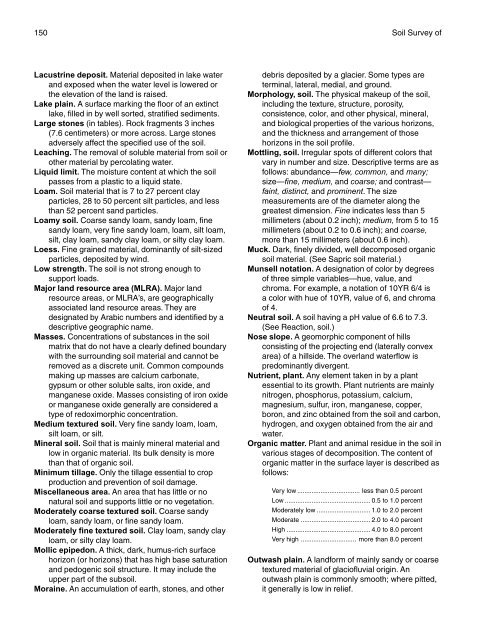Soil Survey of McHenry County, Illinois Part I - Soil Data Mart
Soil Survey of McHenry County, Illinois Part I - Soil Data Mart
Soil Survey of McHenry County, Illinois Part I - Soil Data Mart
Create successful ePaper yourself
Turn your PDF publications into a flip-book with our unique Google optimized e-Paper software.
150 <strong>Soil</strong> <strong>Survey</strong> <strong>of</strong><br />
Lacustrine deposit. Material deposited in lake water<br />
and exposed when the water level is lowered or<br />
the elevation <strong>of</strong> the land is raised.<br />
Lake plain. A surface marking the floor <strong>of</strong> an extinct<br />
lake, filled in by well sorted, stratified sediments.<br />
Large stones (in tables). Rock fragments 3 inches<br />
(7.6 centimeters) or more across. Large stones<br />
adversely affect the specified use <strong>of</strong> the soil.<br />
Leaching. The removal <strong>of</strong> soluble material from soil or<br />
other material by percolating water.<br />
Liquid limit. The moisture content at which the soil<br />
passes from a plastic to a liquid state.<br />
Loam. <strong>Soil</strong> material that is 7 to 27 percent clay<br />
particles, 28 to 50 percent silt particles, and less<br />
than 52 percent sand particles.<br />
Loamy soil. Coarse sandy loam, sandy loam, fine<br />
sandy loam, very fine sandy loam, loam, silt loam,<br />
silt, clay loam, sandy clay loam, or silty clay loam.<br />
Loess. Fine grained material, dominantly <strong>of</strong> silt-sized<br />
particles, deposited by wind.<br />
Low strength. The soil is not strong enough to<br />
support loads.<br />
Major land resource area (MLRA). Major land<br />
resource areas, or MLRA’s, are geographically<br />
associated land resource areas. They are<br />
designated by Arabic numbers and identified by a<br />
descriptive geographic name.<br />
Masses. Concentrations <strong>of</strong> substances in the soil<br />
matrix that do not have a clearly defined boundary<br />
with the surrounding soil material and cannot be<br />
removed as a discrete unit. Common compounds<br />
making up masses are calcium carbonate,<br />
gypsum or other soluble salts, iron oxide, and<br />
manganese oxide. Masses consisting <strong>of</strong> iron oxide<br />
or manganese oxide generally are considered a<br />
type <strong>of</strong> redoximorphic concentration.<br />
Medium textured soil. Very fine sandy loam, loam,<br />
silt loam, or silt.<br />
Mineral soil. <strong>Soil</strong> that is mainly mineral material and<br />
low in organic material. Its bulk density is more<br />
than that <strong>of</strong> organic soil.<br />
Minimum tillage. Only the tillage essential to crop<br />
production and prevention <strong>of</strong> soil damage.<br />
Miscellaneous area. An area that has little or no<br />
natural soil and supports little or no vegetation.<br />
Moderately coarse textured soil. Coarse sandy<br />
loam, sandy loam, or fine sandy loam.<br />
Moderately fine textured soil. Clay loam, sandy clay<br />
loam, or silty clay loam.<br />
Mollic epipedon. A thick, dark, humus-rich surface<br />
horizon (or horizons) that has high base saturation<br />
and pedogenic soil structure. It may include the<br />
upper part <strong>of</strong> the subsoil.<br />
Moraine. An accumulation <strong>of</strong> earth, stones, and other<br />
debris deposited by a glacier. Some types are<br />
terminal, lateral, medial, and ground.<br />
Morphology, soil. The physical makeup <strong>of</strong> the soil,<br />
including the texture, structure, porosity,<br />
consistence, color, and other physical, mineral,<br />
and biological properties <strong>of</strong> the various horizons,<br />
and the thickness and arrangement <strong>of</strong> those<br />
horizons in the soil pr<strong>of</strong>ile.<br />
Mottling, soil. Irregular spots <strong>of</strong> different colors that<br />
vary in number and size. Descriptive terms are as<br />
follows: abundance—few, common, and many;<br />
size—fine, medium, and coarse; and contrast—<br />
faint, distinct, and prominent. The size<br />
measurements are <strong>of</strong> the diameter along the<br />
greatest dimension. Fine indicates less than 5<br />
millimeters (about 0.2 inch); medium, from 5 to 15<br />
millimeters (about 0.2 to 0.6 inch); and coarse,<br />
more than 15 millimeters (about 0.6 inch).<br />
Muck. Dark, finely divided, well decomposed organic<br />
soil material. (See Sapric soil material.)<br />
Munsell notation. A designation <strong>of</strong> color by degrees<br />
<strong>of</strong> three simple variables—hue, value, and<br />
chroma. For example, a notation <strong>of</strong> 10YR 6/4 is<br />
a color with hue <strong>of</strong> 10YR, value <strong>of</strong> 6, and chroma<br />
<strong>of</strong> 4.<br />
Neutral soil. A soil having a pH value <strong>of</strong> 6.6 to 7.3.<br />
(See Reaction, soil.)<br />
Nose slope. A geomorphic component <strong>of</strong> hills<br />
consisting <strong>of</strong> the projecting end (laterally convex<br />
area) <strong>of</strong> a hillside. The overland waterflow is<br />
predominantly divergent.<br />
Nutrient, plant. Any element taken in by a plant<br />
essential to its growth. Plant nutrients are mainly<br />
nitrogen, phosphorus, potassium, calcium,<br />
magnesium, sulfur, iron, manganese, copper,<br />
boron, and zinc obtained from the soil and carbon,<br />
hydrogen, and oxygen obtained from the air and<br />
water.<br />
Organic matter. Plant and animal residue in the soil in<br />
various stages <strong>of</strong> decomposition. The content <strong>of</strong><br />
organic matter in the surface layer is described as<br />
follows:<br />
Very low ................................... less than 0.5 percent<br />
Low ................................................ 0.5 to 1.0 percent<br />
Moderately low .............................. 1.0 to 2.0 percent<br />
Moderate ....................................... 2.0 to 4.0 percent<br />
High ............................................... 4.0 to 8.0 percent<br />
Very high ............................... more than 8.0 percent<br />
Outwash plain. A landform <strong>of</strong> mainly sandy or coarse<br />
textured material <strong>of</strong> glaci<strong>of</strong>luvial origin. An<br />
outwash plain is commonly smooth; where pitted,<br />
it generally is low in relief.

















